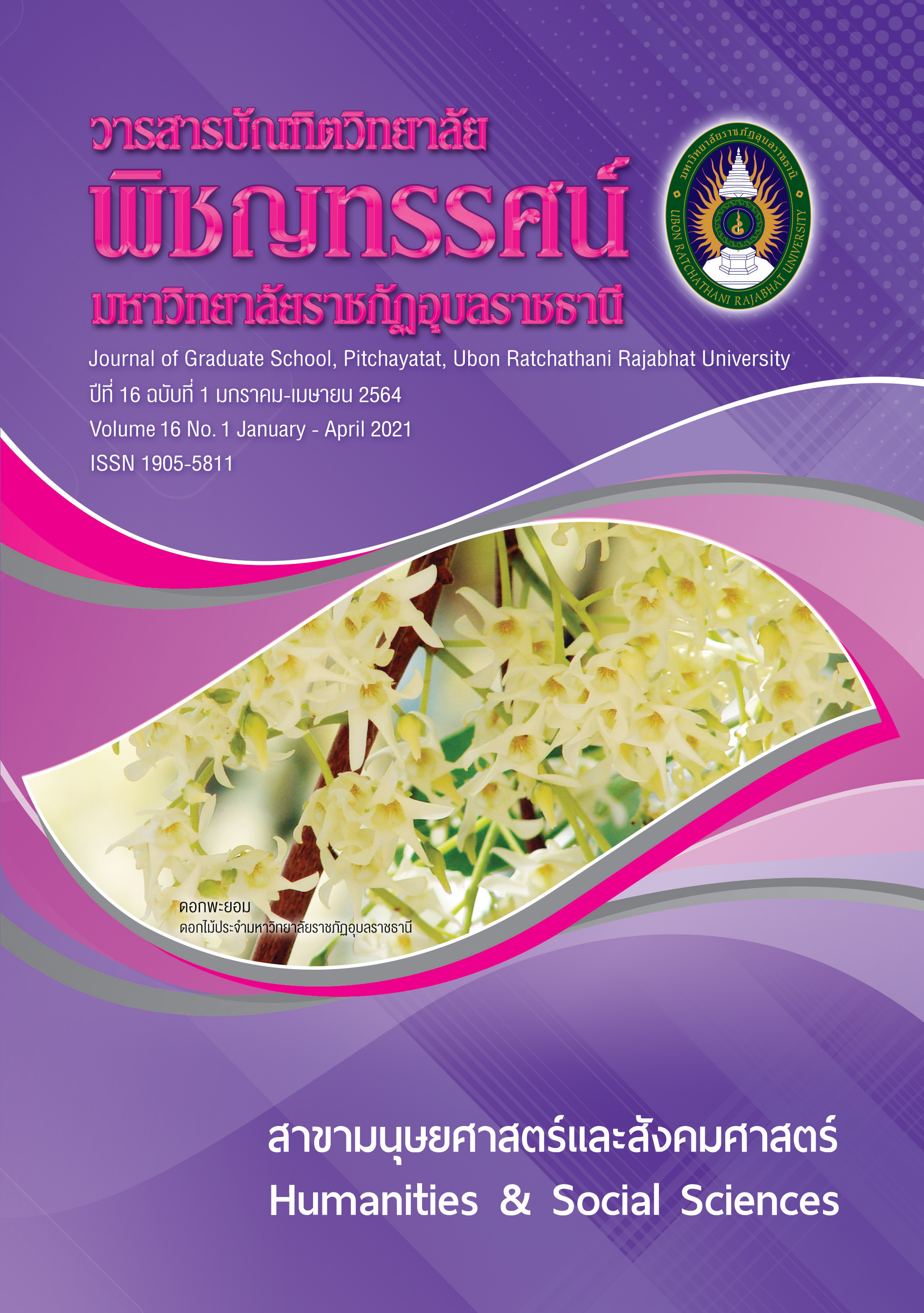แนวทางการพัฒนาศักยภาพการท่องเที่ยวโดยชุมชนบนฐานอัตลักษณ์วัฒนธรรม กลุ่มหัตถกรรมเครื่องทองเหลืองบ้านปะอาว ตำบลปะอาว อำเภอเมือง จังหวัดอุบลราชธานี
คำสำคัญ:
ศักยภาพการท่องเที่ยวโดยชุมชน, อัตลักษณ์ทางวัฒนธรรม, กลุ่มหัตถกรรมเครื่องทองเหลืองบ้านปะอาวบทคัดย่อ
การศึกษานี้เป็นมีวัตถุประสงค์เพื่อพัฒนาศักยภาพด้านการท่องเที่ยวโดยชุมชนบนฐานอัตลักษณ์ทางวัฒนธรรม กลุ่มหัตถกรรมเครื่องทองเหลืองบ้านปะอาว ตำบลปะอาว อำเภอเมือง จังหวัดอุบลราชธานี ใช้วิธีการวิจัยเชิงคุณภาพ คัดเลือกตัวอย่างแบบเฉพาะเจาะจง ได้แก่ กลุ่มนักท่องเที่ยวจำนวน 150 คน และกลุ่มที่เกี่ยวข้องกับการท่องเที่ยวจำนวน 4 กลุ่ม ตัวแทนกลุ่มอาชีพ กลุ่มผู้นำ ตัวแทนภาครัฐและเอกชน วิธีเก็บข้อมูลจากแบบสอบถามออนไลน์ การสัมภาษณ์ การสนทนากลุ่ม และจัดทำกิจกรรมร่วมกับชุมชน โดยใช้แนวคิดและทฤษฎีเกี่ยวกับแนวคิดอัตลักษณ์ทางวัฒนธรรม และแนวคิดเชิงออกแบบ เป็นกรอบในการศึกษา วิเคราะห์ข้อมูลโดยใช้สถิติอย่างง่ายและการพรรณนาเชิงบรรยาย
ผลจากศึกษาพบว่า
จากการสำรวจประเมินสถานการณ์ด้านการท่องเที่ยวโดยชุมชนของกลุ่มหัตถกรรมเครื่องทองเหลืองบ้านปะอาวนั้นมีความพร้อมในด้านทรัพยากรแหล่งท่องเที่ยวโดยชุมชนที่มีความโดดเด่นในด้าน ทางวัฒนธรรมคือ ผลิตภัณฑ์เครื่องทองเหลืองหล่อด้วยกรรมวิธีโบราณที่เหลือแห่งเดียวในประเทศ มีการสืบทอดกันมายาวนานกว่า 5 ชั่วอายุคน และมีการทอผ้าไหมพื้นบ้าน พิพิธภัณฑ์พื้นบ้าน (ศูนย์วัฒนธรรมเฉลิมราช) ประเพณีวัฒนธรรม วิถีชาวนาอีสาน อย่างไรก็ตามชุมชนแห่งนี้ประสบปัญหาด้านการพัฒนาด้านการท่องเที่ยวในด้านบุคลากรที่ขาดความเข้าใจในแนวคิดการท่องเที่ยวโดยชุมชน ขาดผู้สืบทอดด้านภูมิปัญญาท้องถิ่นซึ่งเป็นจุดขายด้านวัฒนธรรมของชุมชน (การหล่อทองเหลือง การทอผ้าไหมโบราณ) ขาดนักสื่อความหมายด้านการท่องเที่ยว เส้นทางการท่องเที่ยวไม่เป็นที่รู้จัก โปรแกรมและกิจกรรมการท่องเที่ยวยังขาดความหลากหลายเป็นที่ดึงดูดใจ เมื่อมีการพัฒนากระบวนการท่องเที่ยวโดยชุมชนผ่านกิจกรรมการอบรมเชิงปฏิบัติการผ่านกระบวนการกลุ่ม สามารถสร้างการเปลี่ยนแปลงดังนี้ มีคู่มือการท่องเที่ยวบ้านปะอาว สร้างผลิตภัณฑ์ทองเหลืองของที่ระลึกจำนวน 2 รูปแบบ มีนักสื่อความหมายที่สามารถเล่าเรื่องด้านการท่องเที่ยวจำนวน 10 คน มีโปรแกรมการท่องเที่ยว 3 รูปแบบ (หนึ่งวัน สองวันหนึ่งคืน สามวันสองคืน) รวมทั้งได้พัฒนากิจกรรมการท่องเที่ยวอย่างมีส่วนร่วมจำนวน 10 ฐานการเรียนรู้ ซึ่งจะนำไปสู่การพัฒนาสร้างความเข้มแข็งในการท่องเที่ยวโดยชุมชนและขยายผลต่อไปในอนาคต
เอกสารอ้างอิง
การท่องเที่ยวและกีฬา, กระทรวง. แผนพัฒนาการท่องเที่ยวแห่งชาติ ฉบับที่ 2 (พ.ศ. 2560-2564). กรุงเทพฯ: องค์การสงเคราะห์ทหารผ่านศึก, 2560.
กาญจนา สุคัณธสิริกุล. การพัฒนาคุณภาพการท่องเที่ยวเชิงวัฒนธรรมในภาคตะวันออก เฉียงเหนือ. สาขาเทคโนโลยีการจัดการ สำนักวิชาเทคโนโลยีสังคม มหาวิทยาลัยเทคโนโลยีสุรนารี, 2556.
กิตติศักดิ์ กลิ่นหมื่นไวย. “แนวทางการส่งเสริมการท่องเที่ยวเชิงวัฒนธรรมชุมชนท่ามะโอ อำเภอเมือง จังหวัดลำปาง,” ศิลปศาสตร์. มหาวิทยาลัยแม่โจ้ 6,1 (มกราคม-มิถุนายน) 2561): 131-148.
ชูสิทธิ์ ชูชาติ. อุตสาหกรรมการท่องเที่ยว. พิมพ์ครั้งที่ 4. เชียงใหม่: มหาวิทยาลัยราชภัฏเชียงใหม่, 2546.
ชัชวาลย์ ทัตศิวัช. (2552). “การวิจัยเชิงปฏิบัติการแบบมีส่วนร่วม (Participatory action research-PAR) : มิติใหม่ของรูปแบบวิธีวิจัย เพื่อการพัฒนาชุมชนระดับท้องถิ่น”. นโยบายสาธารณะที่ดี 4(10); 1-5.
ธาดา ราชกิจ . กระบวนการคิดเชิงออกแบบ (Design Thinking) เครื่องมือสำคัญของการสร้างความสำเร็จให้องค์กร. (ออนไลน์) 3 กรกฎาคม 2562 (อ้างเมื่อ 26 พฤษภาคม 2563). จาก https://th.hrnote.asia/orgdevelopment/190702-design-thinking
ธัญพัชร ศรีมารัตน์. อัตลักษณ์ทางวัฒนธรรมกับกระบวนการกลายเป็นสินค้า : กรณีศึกษาโรงแรม ปิงนครา บูติกโฮเทล แอนด์ สปา เชียงใหม่. วิทยานิพนธ์ศิลปศาสตร์มหาบัณฑิต มหาวิทยาลัยเชียงใหม่, 2558.
นริศรา สารีบุตร วศิน เนียมหอม วัชระชัย บุญน้อย และยุทธศักดิ์ สัณฑมาศ. “การพัฒนาเครื่องประดับจากทองเหลืองตามเอกลักษณ์ท้องถิ่น กรณีศึกษา ศูนย์อนุรักษ์หัตถกรรมทองเหลืองบ้านปะอาว ตำบลปะอาว จังหวัดอุบลราชธานี.” วิจัยและพัฒนา. มหาวิทยาลัยราชภัฏสวนสุนันทา 9, 3 ฉบับเสริม (กรกฏาคม 2560) : 45-52.
ประไพพิมพ์ พานิชสมัย. การออกแบบอัตลักษณ์ส่งเสริมการท่องเที่ยวทางวัฒนธรรมท้องถิ่น ชุมชนท่าแพ จังหวัดนครศรีธรรมราช. วิทยานิพนธ์ศิลปะมหาบัณฑิต มหาวิทยาลัยศิลปากร, 2560.
ไปรมา อิศรเสนา ณ อยุธยา, และชูจิต ตรีรัตนพันธ์. การคิดเชิงออกแบบ: เรียนรู้ด้วยการลงมือทำ. (ออนไลน์) (อ้างถึงเมื่อ 2560). ศูนย์สร้างสรรค์งานออกแบบ TCDC จากhttp://resource.tcdc.or.th/ebook/Design.Thingking.Learning.by.Doing.pdf
ศูนย์ประสานงานเครือข่ายการท่องเที่ยวโดยชุมชน, การท่องเที่ยวโดยชุมชน. (ออนไลน์) 2555 อ้างเมื่อ 20 พฤษภาคม 2563) จาก http://www.thaicommunitybasedtourismnetwork
สุดแดน วิสุทธิลักษณ์. คู่มือการท่องเที่ยวเชิงสร้างสรรค์. กรุงเทพฯ: องค์การบริหารการพัฒนาพื้นที่พิเศษเพื่อการท่องเที่ยวอย่างยั่งยืน, 2556.
เสริมศักดิ์ ขุนพล. “การศึกษาอัตลักษณ์ทางวัฒนธรรมความเชื่อของชุมชนเกาะยอ” ปาริชาติ มหาวิทยาลัยทักษิณ (ปีที่ 25 ฉบับที่ 3 ฉบับพิเศษ สืบเนื่องจากงานประชุมวิชาการระดับชาติ มหาวิทยาลัยทักษิณ ครั้งที่ 25 ประจำปี 2558): 82-103
สำนักงานสถิติแห่งชาติจังหวัดอุบลราชธานี. สถิตินักท่องเที่ยวในจังหวัดอุบลราชธานี. (ออนไลน์) 2561 (อ้างเมื่อ 18 พฤศจิกายน 2561). จาก http://ubon.nso.go.th
องค์การบริหารการพัฒนาพื้นที่พิเศษเพื่อการท่องเที่ยวอย่างยั่งยืน (องค์การมหาชน). เพราะ “วัฒนธรรมไทย” คือสินค้าชิ้นเอกของการท่องเที่ยวสร้างสรรค์. (ออนไลน์) อ้างเมือ 5 พฤษภาคม 2556, จาก http://www.dasta.or.th/th/sustain/detail_sustain. php?ID=237&SystemModuleKey=Create_Statement#.(2556).
Stuart Hall. (1994). Representation: Cultural Representations and Signifying Practices. London : Sage
ดาวน์โหลด
เผยแพร่แล้ว
รูปแบบการอ้างอิง
ฉบับ
ประเภทบทความ
สัญญาอนุญาต
บทความทุกเรื่องได้รับการตรวจความถูกต้องทางวิชาการโดยผู้ทรงคุณวุฒิภายนอกอย่างน้อย 3 คน ความคิดเห็นในวารสารพิชญทรรศน์เป็นความคิดเห็นของผู้นิพนธ์มิใช่ความคิดเห็นของผู้จัดทำ จึงมิใช่ความรับผิดชอบของวารสารพิชญทรรศน์ และบทความในวารสารพิชญทรรศน์สงวนสิทธิ์ตามกฎหมายไทย การจะนำไปเผยแพร่ต้องได้รับอนุญาตเป็นลายลักษณ์อักษรจากกองบรรณาธิการ





